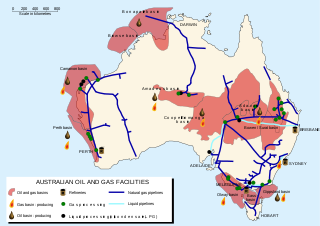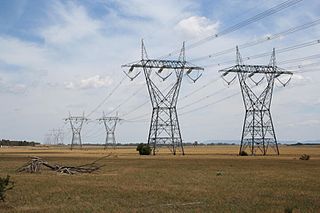
Hydro Tasmania, known for most of its history as the Hydro-Electric Commission (HEC) or simply The Hydro, is the trading name of the Hydro-Electric Corporation, a Tasmanian Government business enterprise which is the main electricity generator in the state of Tasmania, Australia. The Hydro was originally oriented towards hydro-electricity, due to Tasmania's dramatic topography and relatively high rainfall in the central and western parts of the state. Today, Hydro Tasmania operates thirty hydro-electric and one gas power station, and is a joint owner in three wind farms.

ATCO Ltd., operating as the ATCO Group, is a publicly-traded Canadian engineering, logistics and energy holding company based in Calgary, Alberta. ATCO's subsidiaries include electric utilities, natural gas production and distribution companies, and construction companies.
Western Power Corporation (WPC), owned by the Government of Western Australia, was Western Australia's major electricity supplier from 1995 until 2006.

EnergyAustralia was a state–owned enterprise of the Government of New South Wales, Australia. It was electricity and gas supplier and retailer which primarily supplied the Sydney, Newcastle and Central Coast areas of New South Wales. after market deregulation, it increased its focus on retail supply opportunities in electricity and gas to the Victorian market and electricity in the deregulated South East Queensland.
The State Energy Commission of Western Australia was an Australian energy provider. It was established on 1 January 1975 as an amalgamation of the State Electricity Commission of Western Australia and the Fuel and Power Commission.
Alinta Limited was an Australian energy infrastructure company. It has grown from a small, Western Australia–based gas distributor and retailer to the largest energy infrastructure company in Australia. It was bought in 2007 by a consortium including Singapore Power and various parties which include the now defunct Babcock & Brown funds.

Origin Energy Ltd is an ASX listed public company with headquarters in Sydney. It is a major integrated electricity generator, and electricity and natural gas retailer. It operates Eraring Power Station, Australia's largest coal-fired power station, in New South Wales, which it plans to close in 2025. As of 2024, it plans to "minimise" its ownership of wind and solar power, to boost investor returns. It owns 20% of Octopus Energy, a UK renewable energy retailer.

Verve Energy was a Western Australian Government owned corporation responsible for operating the state's electricity generators on the state's South West Interconnected System (SWIS).

Synergy is a corporation owned by the Government of Western Australia. Synergy is Western Australia (WA)’s largest energy retailer and generator with more than one million industrial, commercial and residential customers, generating total annual revenue of more than $3.2 billion.
The Victorian Energy Networks Corporation (VENCorp) was a Victorian State Government-owned entity established on 11 December 1997 responsible for the efficient operation of gas and electricity industries in Victoria, Australia, within Victoria's privatised energy industries. It was funded by energy industry participants.
Western Power is a statutory corporation established by the Electricity Corporations Act 2005 (WA). It is owned by the State Government of Western Australia and is accountable to the Minister for Energy. It is responsible for building, maintaining and operating the electricity network within the South West Interconnected System (SWIS), the poles and wires or energy grid.

The energy policy of Australia is subject to the regulatory and fiscal influence of all three levels of government in Australia, although only the State and Federal levels determine policy for primary industries such as coal. Federal policies for energy in Australia continue to support the coal mining and natural gas industries through subsidies for fossil fuel use and production. Australia is the 10th most coal-dependent country in the world. Coal and natural gas, along with oil-based products, are currently the primary sources of Australian energy usage and the coal industry produces over 30% of Australia's total greenhouse gas emissions. In 2018 Australia was the 8th highest emitter of greenhouse gases per capita in the world.

Energy in Victoria, Australia is generated using a number of fuels or technologies, including coal, natural gas and renewable energy sources. Brown coal, historically, was the main primary energy source for the generation of electricity in the state, accounting for about 85% of electricity generation in 2008. The amount of coal-fired power has decreased significantly with the closure in 2017 of the Hazelwood Power Station which supplied around 20% of Victoria's electricity, and to a lesser extent with the exit of Anglesea Power Station in 2015. Brown coal is one of the largest contributors to Australia's total domestic greenhouse gas emissions and a source of controversy for the country. Australia is one of the highest polluters of greenhouse gas per capita in the world.

Queensland's energy policy is based on the year 2000 document called the Queensland Energy Policy: A Cleaner Energy Strategy. The Queensland Government assists energy development through the Department of Energy and Water Supply. The state is noted for its significant contribution to coal mining in Australia. The primary fuel for electricity generation in the state is coal with coal seam gas becoming a significant fuel source. Queensland has 98% of Australia's reserves of coal seam gas. An expansion of energy-intensive industries such as mining, economic growth and population growth have created increased demand for energy in Queensland.

SGSP (Australia) Assets Pty Ltd (SGSPAA), trading as Jemena, is an Australian company that owns, manages or operates energy infrastructure assets in the eastern states of Australia including Queensland and New South Wales, and gas pipelines and gas and electricity distribution networks in Victoria and the Northern Territory. It is 60% owned by State Grid Corporation of China and 40% by Singapore Power.
The Australian Energy Market Operator (AEMO) performs an array of gas and electricity market, operational, development and planning functions. It manages the National Electricity Market (NEM), the Wholesale Electricity Market (WA) (WEM) and the Victorian gas transmission network. AEMO also facilitates electricity and gas full retail contestability, overseeing these retail markets in eastern and southern Australia. It is additionally responsible for national transmission planning for electricity and the establishment of a Short Term Trading Market (STTM) for gas.
Kwinana Cogeneration Plant was a cogeneration facility located 40 kilometres (25 mi) south of Perth, Western Australia that operated from 1994 to 2022. It provided steam and electrical power to the BP Australia Kwinana Oil Refinery and electricity to Synergy, the State owned generator/retailer.

Engie Australia, previously Simply Energy, is an Australian energy retailer, providing electricity and gas to more than 700,000 accounts across Victoria, South Australia, New South Wales, Queensland and Western Australia, with sales totalling 12% of the Australian market. It is the Australian retail arm of French company ENGIE. It was rebranded from Simply Energy in 2024.
Western Australia, like other Australian states and high-income countries, is a heavy energy user by global standards.










